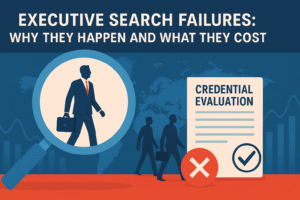
Executive search is one of the most high-stakes processes in the business world. Companies invest significant time and money into finding the right leaders, yet studies consistently show that a large percentage of executive hires fail within their first few years. Understanding the patterns behind these failures by region, cause, and industry can help organizations and search firms reduce risk and improve outcomes.
The Scale of the Problem
Globally, research indicates that approximately 40-50% of executives fail within the first 18 months of assuming a new role. In some cases, the failure is visible within a year; in others, it unfolds over several years as the executive and the organization part ways.
- In North America and Europe, the numbers are remarkably consistent: about half of external executive hires don’t last beyond 18 months.
- In Asia, there has been a slight counter-trend, with CEO turnover stabilizing or even decreasing in recent years. Cultural emphasis on continuity and careful succession planning has contributed to lower early turnover rates.
- One important distinction is between external hires and internal promotions. Executives promoted from within tend to succeed at much higher rates. External hires, by contrast, are more than 60 percent more likely to fail within a short period.
Why Executive Searches Fail
The causes of executive hiring failures are surprisingly consistent across regions and industries. The top reasons include:
- Cultural mismatch: Technical skills are rarely the problem. The primary reason executives fail early is a poor fit with the organization’s culture, values, or team.
- Flawed hiring process: Many searches are undermined by unstructured interviews, shifting job descriptions, slow decision-making, or unclear alignment among stakeholders. These process breakdowns lead to poor choices or to searches that fail to deliver any hire at all.
- Misrepresentation or credential fraud: Even at the highest levels, resumes are often inflated. Without rigorous verification, companies risk bringing in executives with overstated or falsified backgrounds.
- Misaligned expectations: Executives sometimes enter a role with one understanding of scope or authority, only to find the reality is very different. A lack of onboarding support and stakeholder alignment can quickly erode confidence.
- Other factors: Compensation disputes, internal politics, or resistance to change often derail otherwise qualified hires.
The Consequences of Failure
When an executive hire fails, the costs go far beyond recruitment fees. A failed search or early departure leads to:
- Early turnover: Nearly one-third of CEOs worldwide don’t last beyond their third year in the role.
- Financial impact: Estimates vary, but the cost of a failed executive hire can range from 200 percent of annual salary in direct costs to as much as 15 times salary when lost opportunities and organizational disruption are factored in.
- Lost momentum: Critical strategies and initiatives stall when leadership churn interrupts execution.
- Cultural and reputational damage: Repeated leadership failures erode employee trust, unsettle boards and investors, and damage the employer brand.
Failures by Sector
Turnover rates also vary significantly across industries. Some sectors are more prone to executive churn, while others enjoy relative stability.
| Industry Sector | Annual CEO Turnover Rate | Notes |
| Healthcare | ~15% per year | High pressure and burnout contribute to some of the highest CEO turnover rates, particularly in hospitals and healthcare systems. |
| Hospitality & Leisure | ~16% per year | Frequent disruptions and performance pressure drive high CEO turnover in this sector. |
| Technology | ~13% per year | Fast-moving markets, M&A activity, and rapid growth contribute to above-average turnover. |
| Consumer & Retail | ~12% per year | Activist investors and intense performance scrutiny make this sector volatile for executives. |
| Financial Services | ~7% per year | A relatively stable sector, with stricter regulatory environments and longer CEO tenures. |
These sector differences show that context matters. Organizations in volatile, fast-changing industries, such as retail or tech, face a higher risk of short executive tenures, making robust search and onboarding processes even more crucial.
What Companies Can Do
The lessons from executive search failures are clear:
- Invest in cultural fit assessments as much as you do in technical and leadership evaluations.
- Use structured, data-driven hiring processes instead of relying on intuition.
- Verify credentials thoroughly to reduce fraud and misrepresentation.
- Support new executives with onboarding and integration plans.
- Build stronger succession pipelines to reduce reliance on external hires.
Executive search failures are costly, but they are not inevitable. By understanding the patterns behind why leaders fail and addressing the most common pitfalls, organizations can significantly improve their chances of finding and retaining leaders who will thrive.
Contact us today to discover how our credential evaluation services can enhance your job search process and protect your professional reputation.
